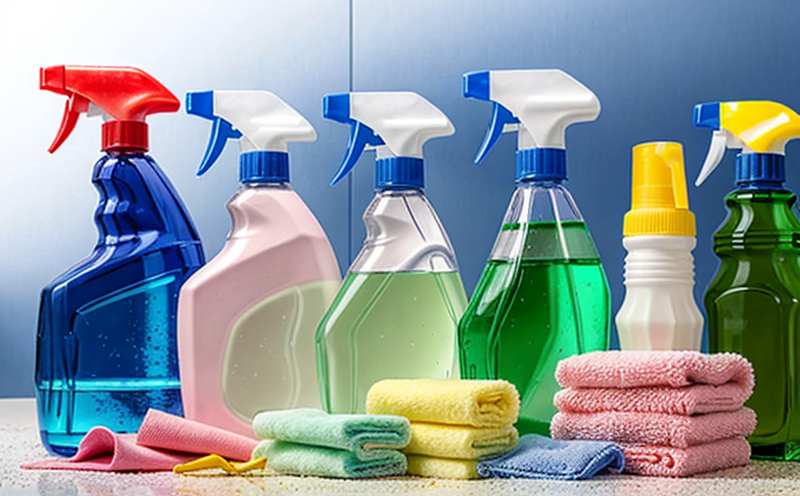Foam Stability Testing in Detergents
In the realm of consumer products and product safety testing, foam stability is a critical attribute that directly influences customer satisfaction and product performance. Foam stability refers to the ability of a detergent solution to form and maintain stable foam under specific conditions. This characteristic ensures that the cleaning agent not only cleans effectively but also provides an appealing visual experience during use.
The importance of foam stability in detergents cannot be overstated, especially given the consumer preference for products that offer both functionality and aesthetic appeal. In many cultures, a good foaming detergent is seen as a sign of a high-quality cleaning product. This attribute enhances user satisfaction by offering an immediate visual confirmation of the detergent's effectiveness.
The foam stability test assesses the quality of detergents in terms of their ability to produce and maintain stable foam over time. The process involves measuring the volume, height, and duration of foam formation after a specified amount of detergent is mixed with water under controlled conditions. This test is essential for ensuring that the product meets consumer expectations and regulatory requirements.
Understanding the foam stability of detergents requires knowledge of various factors including surfactant type, concentration, temperature, pH level, and agitation speed. These parameters significantly influence how a detergent forms and maintains its foam. For instance, higher concentrations of certain surfactants can lead to more robust foams, but they may also cause excessive foam that could be uncomfortable for users.
Given the complexity of these variables, it is crucial to conduct thorough testing using standardized methods. International standards such as ISO 12945-3 provide guidelines on how to perform foam stability tests accurately and consistently across different laboratories. Compliance with these standards ensures that results are reliable and comparable worldwide.
The impact of foam stability extends beyond mere aesthetics; it plays a vital role in the overall effectiveness of detergents. Stable foams help trap dirt, grease, and other contaminants more effectively than unstable ones. Additionally, they contribute to better rinse-off properties, reducing the amount of residue left on fabrics or surfaces after washing.
For R&D engineers working on new detergent formulations, foam stability testing is an indispensable tool for optimizing product performance. By understanding how changes in ingredients and formulation affect foam stability, they can develop products that meet market demands while adhering to strict safety regulations.
Benefits
- Enhanced Consumer Satisfaction: Stable foams provide a more satisfying user experience, leading to higher customer satisfaction and loyalty.
- Better Cleaning Efficiency: Stable foams help in trapping dirt and grease more effectively, thus enhancing the cleaning power of detergents.
- Improved Product Performance: By ensuring consistent foam stability, manufacturers can improve the overall quality and reliability of their products.
- Regulatory Compliance: Adherence to international standards guarantees compliance with local regulations, thereby avoiding potential legal issues.
- Cost Efficiency: Accurate testing helps in optimizing ingredient usage, reducing waste, and minimizing production costs without sacrificing quality.
Quality and Reliability Assurance
The foam stability test is a cornerstone of quality assurance programs for detergent manufacturers. By regularly conducting these tests, companies can ensure that their products consistently meet the highest standards in terms of performance and safety.
Implementing robust quality control measures involves not only performing regular foam stability tests but also maintaining detailed records of all testing activities. These records serve as valuable tools for identifying trends, detecting potential issues early on, and making data-driven decisions regarding product development and manufacturing processes.
R&D teams rely heavily on the results from foam stability tests to refine their products continuously. They analyze various factors such as surfactant type, concentration, temperature, pH level, and agitation speed to determine which combinations yield the most stable foams. This iterative process allows them to innovate without compromising product integrity.
Compliance officers play a crucial role in ensuring that all testing processes comply with relevant international standards like ISO 12945-3. Their responsibilities include overseeing the setup and execution of tests, verifying adherence to standard protocols, and documenting findings meticulously. Proper documentation helps in defending against any potential claims or audits related to product quality.
In addition to internal checks, many companies also invite third-party experts to conduct independent reviews periodically. These external evaluations provide an unbiased perspective on the effectiveness of their quality assurance practices. Such collaborations foster continuous improvement by exposing areas needing attention and encouraging best practice adoption.
Environmental and Sustainability Contributions
Incorporating foam stability testing into sustainability initiatives offers several benefits for both the environment and consumers. Stable foams contribute to more effective cleaning, which can reduce water usage since less detergent is needed to achieve satisfactory results.
Moreover, stable foams aid in better rinsing, which minimizes the amount of residual detergent left behind after washing. This reduces environmental pollution caused by excess detergent runoff into natural water bodies. Consumers appreciate these eco-friendly features as they align with growing consumer awareness about environmental responsibility.
The foam stability test also plays a part in designing more sustainable product formulations. By identifying surfactants and concentrations that produce stable foams, R&D teams can reduce the use of harsh chemicals or large quantities of water during production processes. This translates into lower energy consumption throughout the lifecycle of the product.
Manufacturers who adopt sustainable practices like these are increasingly sought after by environmentally-conscious consumers. As sustainability becomes a key driver in purchasing decisions, incorporating foam stability testing into product development strategies can give companies a competitive edge in the market.





